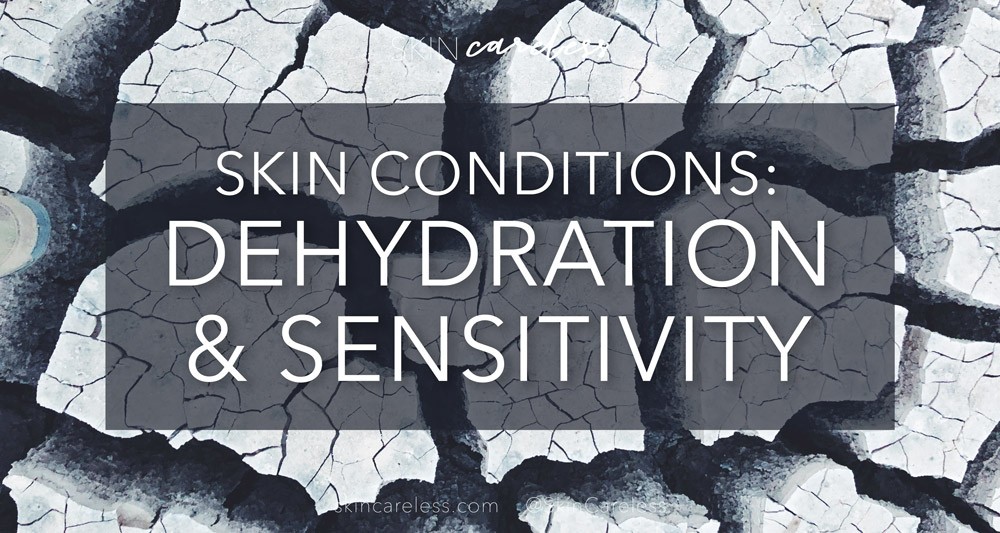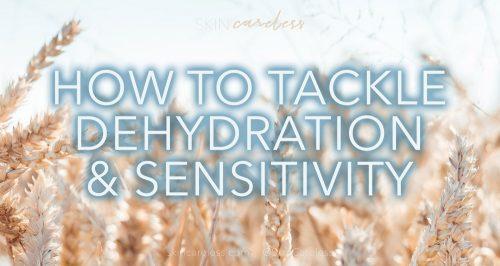These two ‘incognito’ skin conditions are two sides of the same coin – could be at the root of more of your skin problems than you realise. They can both be caused by harsh treatment (such as using products like baking soda), irritating ingredients and improper moisturisation.
Recognising dehydrated skin
Dehydrated skin lacks water (as opposed to dry skin which lacks oil, remember?). Deep down, the skin cells absorb water from the rest of our body and blood. As we reach closer to the surface, water keeps skin looking plump and feeling flexible.
It’s the job of our skin’s natural oils and other natural moisturising factors that live between our skin cells to trap water deep in the skin. As oil and water don’t mix, they can effectively block the water’s escape as it tries to evaporate. Done right, your natural oils or the humectants, emollients and occlusives you use to supplement them should keep your skin sufficiently hydrated.
Done wrong, the skin is lacking in water and often becomes intensely parched and flaky. Dehydration makes fine lines and pores more pronounced, and your skin will not feel smooth or supple.
The distinction between natural dry and temporarily dehydrated skin gets confusing because the dry skin type and dehydrated skin condition co-exist a lot of the time.
For those with dry skin and less natural oils to lock in the water, you’re more likely to lose necessary moisture to evaporation unless you’re using sufficiently rich skin products. These dry and dehydrated people might suffer from eczema and dermatitis, rough, peeling and cracking skin, and a tight burning sensation, especially in the winter months.
However many people, myself included, experience dehydration as overly oily skin. When I suffered from this, my skin felt rough, tight and dry but illogically would get greasy really quickly. Once I started to treat my skin with moisture and gentle care instead of stripping it dry, the oil production quickly settled down. I now have a far more balanced skin type. I believe many people are experiencing a dehydrated skin condition and mistaking it for a very oily skin type. Do you see excess oil during the day, but have a rough or irritated skin texture and it seems that light moisturisers and foaming or gel cleansers are only making your skin feel drier and look shinier faster? Consider going against your instincts and treating your skin for dehydration.
Identifying sensitive skin
If your skin stings when you apply products, itches, or has blotchy patches or diffuse (general) redness, it may be sensitised.
This is different from naturally reactive skin, which can often flush with gentle touch. Sensitive skin is overly fussy with products and causes discomfort.
This skin issue (apart from when it’s trigged by actual allergies to products) is often because of extreme dehydration from harsh skin care or irritation from potent products. This can include habits like over-cleansing and using products containing irritating plant extracts or alcohol.
Repeated irritation and dehydration in this way can sensitise the skin to the most bland moisturisers – even plain water! Things that are normally fine will begin to sting.
Are you are using bar soap or body wash on your face, washing more than twice daily, standing under very hot shower water, or not using a moisturiser? If so, and you believe that your skin is just ‘sensitive’ by nature, it could be that it just needs to be treated with a little more care.
How to treat dehydration and sensitivity
Figured out that dehydration and sensitivity are issues you suffer from? Get all the info on how to treat them in my next article here.






[…] antioxidants and more. A good, basic moisturiser should be geared towards your skin type and condition, and contain some key moisturising […]
[…] the skin from bacteria and dehydration. Stripping these can cause a host of issues like acne, dehydration or sensitivity. Not to mention that acne fighting ingredients almost always perform better when used in a leave-on […]
[…] female and could run a deep fryer off my forehead in the morning. Focus on working out your skin conditions and skin type, finding products that give you good results and then run with […]
[…] so damaged from improper care with strong medication that I had created a new issue – severe dehydration and sensitivity. Acne was less of a problem though it still reared its ugly head from time to time. Even though I […]
[…] This sebum is one of the components of our acid mantle – a pH-balanced barrier of sorts that keeps bacteria and other nasties out and moisture in. Not enough oil will cause tightness, as your skin loses water and pliability and starts literally stretching and tearing. Ouch. The next stage after repeated untreated tightness usually is dehydration and sensitivity – think redness, stinging and worse. […]
[…] You can get a head start on pollution by keeping your skin strong with a natural barrier that repels damage. Make use of ingredients like ceramides and oils that support strong skin. That also means avoiding overuse of products like AHAs and retinol, as while they offer great skin benefits they definitely increase your susceptibility to the elements, including pollution, by temporarily thinning the skin and potentially causing sensitivity and dehydration. […]
[…] seems counter intuitive, but acne loves dehydrated skin. Dehydration is caused by the loss of the protective barrier (called the acid mantle) from rough […]
[…] I hope this post helped you to figure out what skin type you have and how you should care for it. Looking for more information to explain why your skin is acting the way it is? Here’s what causes skin conditions like dehydration and sensitivity. […]
[…] you’re suffering from dehydration and sensitivity, it can really affect your skin in more ways that one. Not only will you be prone to redness and discomfort, you skin may look dull, dry, wrinkled, and […]
[…] used but it would be great for someone trying actives for the first time or who has suffered from dehydration and sensitivity or rosacea and is worried about aggravating their […]
[…] or lactic acid, but a subtler and longer lasting sensation. I will say that if you have any irritated or broken skin, or eczema like me, you’ll want to avoid putting this on those areas – the sting will […]
[…] big side effect is excess dryness of the skin, which can develop further into dehydration, irritation, redness and sensitivity, and even burning and stinging with prolonged use. If you have […]